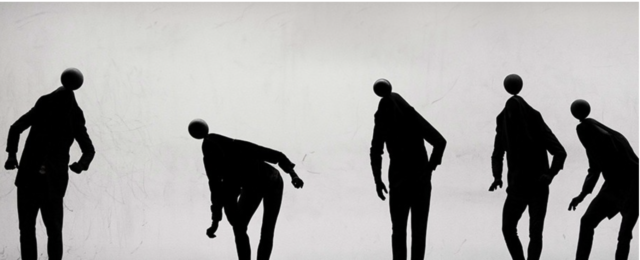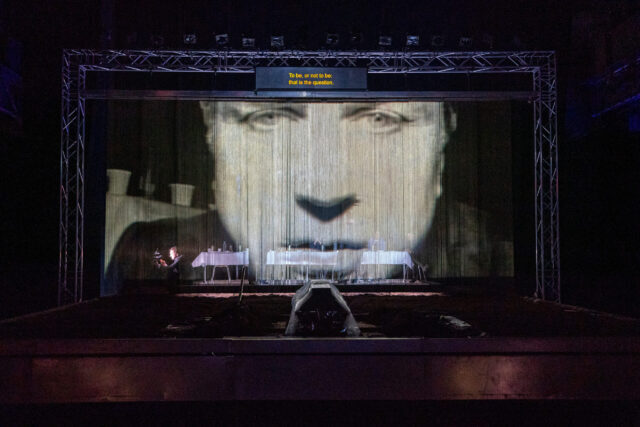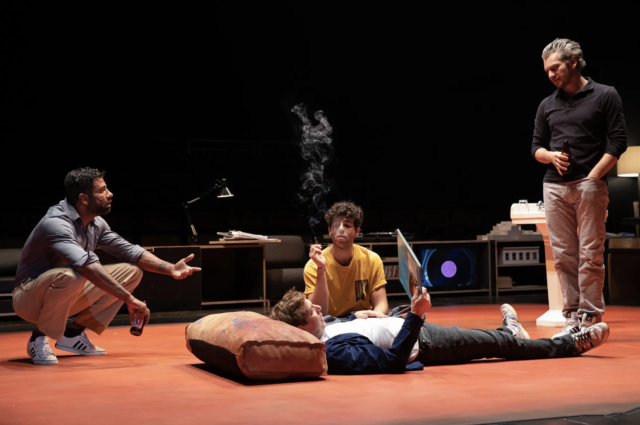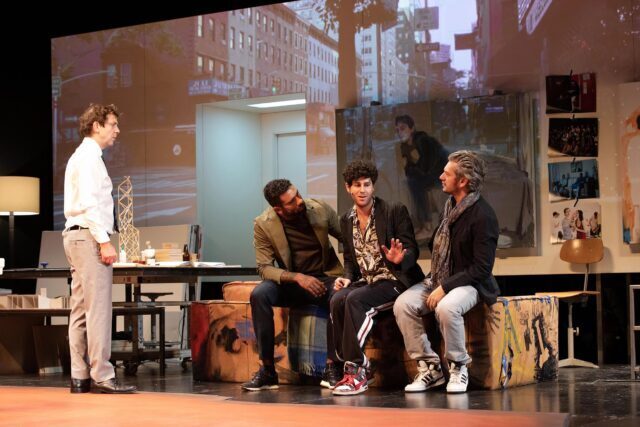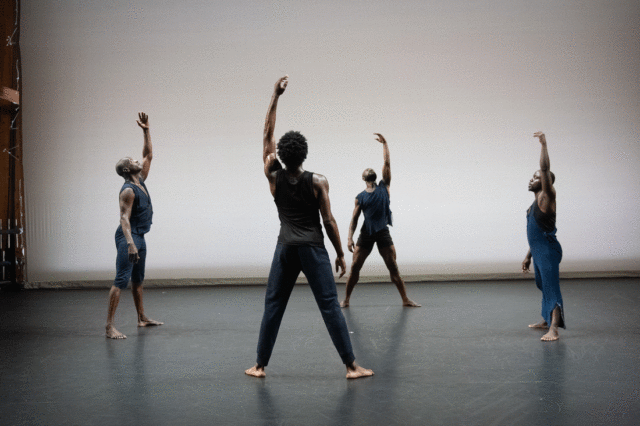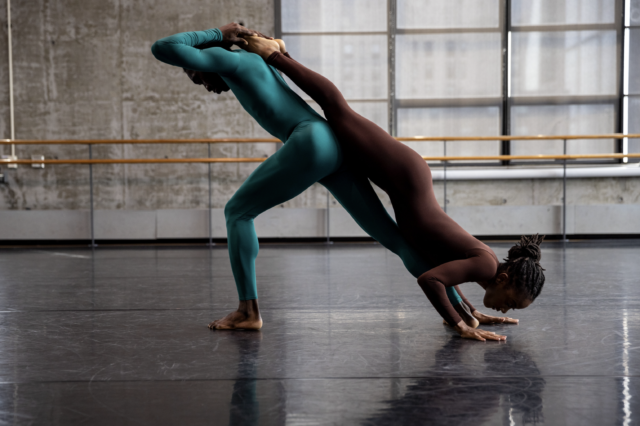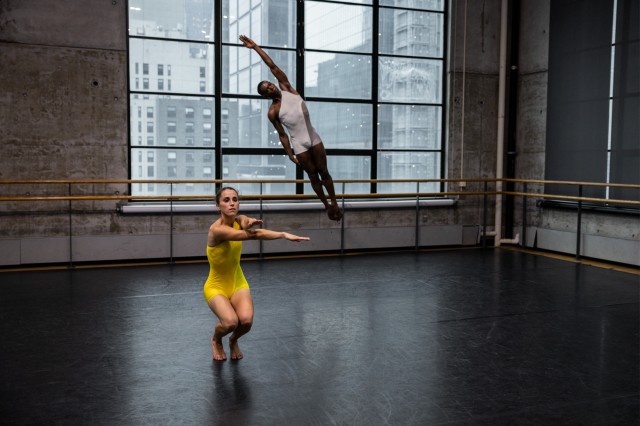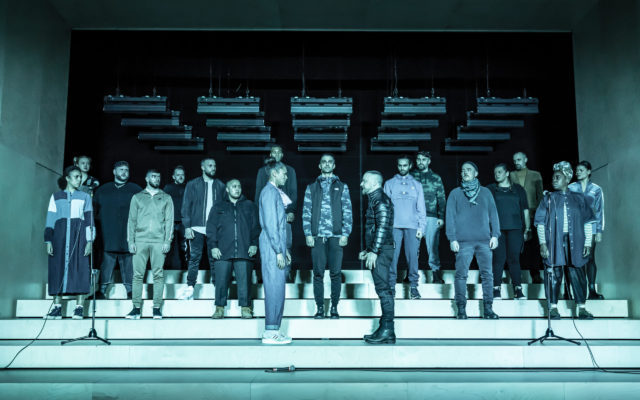
Jamie Lloyd’s reimagining of Cyrano de Bergerac continues at BAM through May 22 (photo by Marc Brenner)
CYRANO DE BERGERAC
Brooklyn Academy of Music
BAM Strong, Harvey Theater
651 Fulton St. between Ashland & Rockwell Pl.
Tuesday – Sunday through May 22, $45-$310
718-636-4100
www.bam.org/cyrano
Jamie Lloyd reimagines Edmond Rostand’s Cyrano de Bergerac for the twenty-first century in his electrifying, Olivier-winning production that continues tearing down the house at the BAM Harvey through May 22.
As the play opens and a swarm of young people in contemporary street clothes congregate on a stark white stage, one man sits in a chair with his back to the audience, gazing into a mirror as if he can’t look away. We know it’s James McAvoy, the gorgeous Scottish superstar, portraying nobleman, soldier, and poet Cyrano de Bergerac sans the character’s famously large and ugly proboscis. But still, when he finally turns around, there’s an audible gasp from the audience; McAvoy, in tight-fitting black jeans, boots, and jacket, is even hotter than we imagined. If he has a problem with the way he looks, what does that say about the rest of us?
However, Ligniere (Nima Taleghani) declares, “The Parisian isn’t superior / just everyone else is inferior.” Thus, director Lloyd and translator and adaptor Martin Crimp are leveling the playing field from the start; we all have things about ourselves that we think are ugly, on the surface and/or inside.
Meanwhile, university student Roxane (Evelyn Miller) demands to be recognized as more than just a pretty face, insisting on being respected for her brains more than her beauty, although she has fallen head-over-heels for the simpleton Christian (Eben Figueiredo), who is most definitely not the brightest bulb in the chandelier. Roxane is not always portrayed as a strong, intelligent character who exists outside of her cousin, Cyrano, and Christian, but she is very much her own woman here. “I am so, so bored with not being taken seriously by men,” she says.
Rostand’s 1897 original is a tribute to the power and glory of speech and the written word; Lloyd and Crimp now further that to the spoken word via rap, as if Cyrano is taking place in a hip-hop battle straight out of Eminem’s 8 Mile. “They say when he came through his mother’s vagina / his nose poked out first as a painful reminder / of all the agony to come,” one character explains.
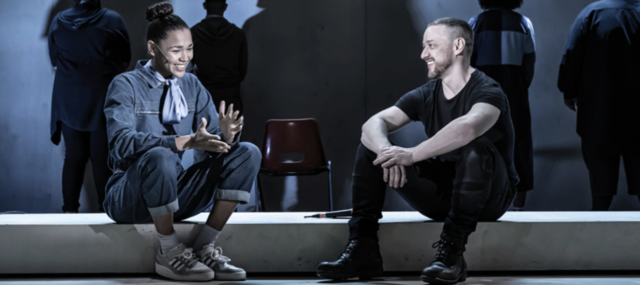
Roxane (Evelyn Miller) and Cyrano (James McAvoy) enjoy a rare laugh together in electrifying adaptation at BAM (photo by Marc Brenner)
“When you first see it you say to yourself NO! ―/ that is a party-trick ― take it off, Cyrano,” the poet and pastry chef Ragueneau (Michele Austin) says about the nose. “You expect him to reach up and somehow unscrew it. / But the damage is done: He can never undo it.” Ragueneau, played by a woman in this version, is Roxane’s best friend and regular companion.
Cyrano is madly in love with Roxane, who is being unsuccessfully set up by the villainous De Guiche (Tom Edden) to wed the young nobleman Valvert and thereafter be shared with De Guiche, who sends Cyrano and Christian off to a military conflict they might not return from. Cyrano himself declares, “If style points you in a sexual direction / You might want to refer, Valvert, to my nasal erection.”
Through all its iterations, including the 1950 film with José Ferrer, the 1987 rom-com with Steve Martin, and the 2019 theater musical (and later film) with Peter Dinklage, Cyrano is about the unrequited love of a lover of language who has to hide behind his ugly facade to help another man capture the heart of a not necessarily strong-willed, self-capable woman he believes he is destined to be with.
Lloyd (Betrayal, Three Days of Rain), who presented a more traditional Cyrano for Roundabout in 2012, complete with a balcony scene and Douglas Hodge wearing a fake nose, this time has streamlined the visuals. Soutra Gilmour’s set is a big white box in which stairs move in and out, with overhead fluorescent lights creating haunting shadows. (Gilmour also designed the costumes; the lighting is by Jon Clark, with music and sound by Ben and Max Ringham.) Instead of parrying with their swords, characters fight it out with microphones, either attached to their head, held in their hand, or on a stand.
A beatboxer (Vaneeka Dadhria) serves as a kind of narrator throughout, but the rapping, which can be thrilling, gets to be too much. Like Cyrano, Rostand is a master wordsmith with an infectious love of the lexicon, which doesn’t always come through, even when the phrase “I love words, that’s all,” is projected onto the back wall. The play works significantly better when it slows down and focuses on the relationships, when the music stops and the tension between Cyrano, Roxane, Christian, De Guiche, and Ragueneau takes center stage (although one intimate scene with Cyrano and Christian goes wildly awry).
McAvoy (The Ruling Class, The Last King of Scotland), in a role previously performed by Martin, Ferrer, Hodge, Ralph Richardson, Derek Jacobi, Richard Chamberlain, Christopher Plummer, Gérard Depardieu, and Kevin Kline, among others over the last century-plus, sizzles as Cyrano; he dominates the Harvey with a magnetic power, his intense sensuality increasing with his every move. Miller (Flowers in the Attic, Jane Eyre) brings depth and a fierce perceptiveness to Roxane, although it is never clear why such a strong, brave woman is enraptured with the dimwitted Christian, who is no hot hunk, but that is all part of Lloyd’s twisting of expectations.
And in the end, like most of us, despite Cyrano’s romance with language itself, he is at a loss of words when expressing his desire for Roxane. He stumbles, “I’m speechless, speechless, all I can say is I want — I want — I want — there is no poetry — there is no structure that can make any sense of this — only I want — I want — I want — I want you.” It’s that passion that drives Lloyd’s unique reinterpretation of a classic.
